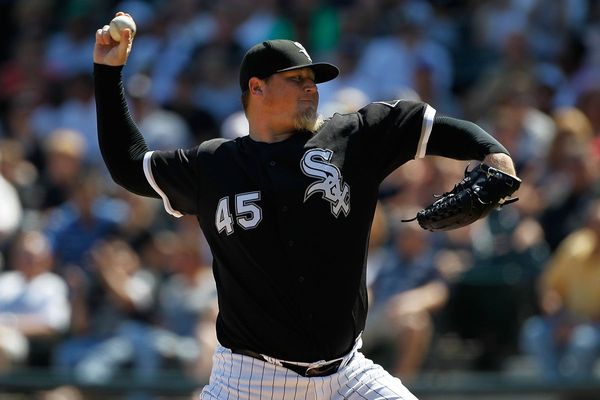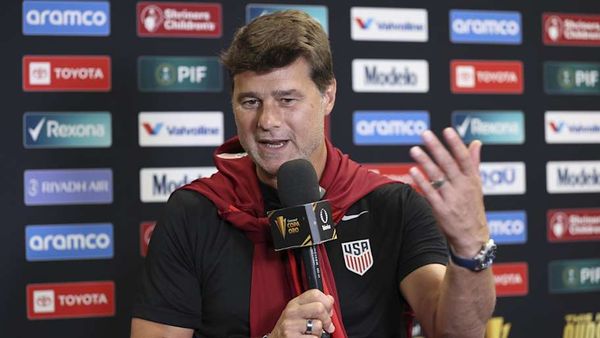
From the elevated deck of his command post, Col Gen Oleksandr Syrskyi, the head of Ukraine’s ground forces, peers down with pinched eyes and furrowed brow at the expanse of scrubland and forest laid out in front of him as an assault unit of soldiers seeks to cross a heavily mined field.
It is evident that the general would like a little more speed.
“This isn’t a show,” says Syrskyi. The men running from trench to armoured vehicles are preparing for battle. The scene being played out for the general at a military camp in the east of Ukraine was one of their final exercises – and designed to impress.
“Ordinarily, it would be quicker,” Syrskyi says when asked whether he is content with what he has seen.
He is attentive to the large screens relaying drone footage to the triangular three-decked command post and scrupulously polite to the officers leaning in to earnestly brief him, speaking into his right ear, about the movements of the sappers, tanks and armoured vehicles ranging in front of him.
But there is a restlessness to the general – under six feet tall, slim, but broad at the shoulders and thick in the forearms – as he stands in a huddle of his fellow officers and soldiers under the hot midday sun.
Syrskyi, 57, may be the second most senior army officer in Ukraine behind Valeriy Zaluzhny, the overall commander of the country’s armed forces, but it is on him that many have pinned their hopes of another breakthrough in the war with Vladimir Putin’s Russia.

It was Syrskyi who led the defence of Kyiv last February and March as Putin’s forces were bearing down on Ukraine’s capital with the mission of decapitating the country’s leadership. He was made a Hero of Ukraine, the country’s highest honour, for his efforts. “He didn’t sleep for three days after 24 February,” says an aide.
Syrskyi was also credited with the execution of a plan to push Russia’s artillery far enough away from the north-eastern city of Kharkiv to spare civilians who had been living under constant fire, before he was said to have masterminded the counteroffensive that broke through Russian lines and liberated the wider region.
But, as the Economist recently reported, “Syrskyi’s brilliance faces a momentous challenge”.
For months, there had been talk of Ukraine’s “spring” counteroffensive. The miracles of the battles for Kyiv, Kharkiv and then the liberation of the north of the Kherson region has made the Ukrainian public, and western capitals, hungry for more glory or at least some revitalising signs that, after 16 months, the war can be won.

Two weeks ago, that much-vaunted offensive began in the east under Syrskyi’s operational command. It has been hard going. This week, Volodymyr Zelenskiy, while insisting that the world should leave Ukraine to implement its own battle plan, conceded that progress was “slower than we want”.
Syrskyi, now sitting on some old tyres by a small village of military tents in the camp, the location of which is being withheld for security reasons, makes no bones about the difficulty of what his soldiers are trying to perform. “It’s difficult, stressful,” he says of the latest developments on the frontline.
Russia has been pursuing its own offensives near the town of Kreminna in the Luhansk region in the east of the country, while on Tuesday there was “hard fighting” in the Serebryansky forest, on the border of the Donetsk region, he says.
The Kremlin has moved units such as the 83 assault paratrooper brigade to Bakhmut from the south, he says, after the breaching of the Kakhovka dam in the southerly Kherson region made the passing of the Dnipro River – which would be necessary for Ukraine to liberate the remaining occupied territory there – even more daunting.

Syrskyi goes on to describe a dizzying number of moves on the battlefield. The pieces on the chessboard are clear in his mind. But the bottom line sounds ominous: “The Russians are trying to seize the initiative, so the situation is really difficult.”
None of this was unexpected, says Syrskyi, who was born in Vladimir, then in the Soviet Union and now in Russia. While some in the Ukrainian military may find comfort in traducing the Russian war effort, enjoying some of the indiscipline and mutiny shared on social media, he describes the situation largely without any such complicating emotion.
“We must not underestimate the enemy,” he says. “The enemy has anticipated and continues to anticipate the most dangerous directions of our movements, and builds up strong defences there that are quite difficult to penetrate.”
Asked about the key to Ukraine’s successes since Putin invaded, Syrskyi puts it down to motivation and training. “Then even the fewer number can and did scatter a more numerous enemy,” he says. “I have never fought against a lesser number of enemy; they have always outnumbered us.
“And the third factor is detailed planning of all our operations and action – very detailed preparation. The planning shows how well we have studied the peculiarities of the theatre of action, how well we are using the topographical features. Of course, we see the enemy’s strengths and weaknesses, and we must take all of that into account.”

Syrskyi is a history buff and his own recent past makes good reading. In the battle for Kyiv, he explains that a turning point was when Russian marines, paratroopers and special forces were approaching the village of Moshchun, just to the north-west of the capital. Ukrainian troops had blown up the bridges crossing the Irpin River as they had retreated but Moshchun remained a gateway.
“The defence of Moshchun is an example of what I said about careful planning,” he said. “The Irpin flows into the Kyiv sea [a local term for the city’s reservoir], but its level is lower than the level of the reservoir. The water from Irpin is pumped into the reservoir by a powerful pumping station over a dam. So, realising that we were outnumbered at Moshchun, we made a small opening in the upper part of the dam. We used the features of the landscape. We raised the sluices and flooded the entire area in front of Moshchun that had been occupied by the enemy.”
The liberation of the Kharkiv region, meanwhile, was completed through the splitting and outflanking of Putin’s troops as a result of weakness being spotted in the Russian lines near the town of Balakliia earlier in the summer. At the time, Syrskyi was prioritising pushing the Russians farther away from Kharkiv city but later that autumn he went on to exploit what he had seen.
“Starting in June, I was commanding the operation in the east and we considered our possibilities for a counteroffensive while we were engaged in defensive fighting,” he says. “Even during the first operation, I considered our future possibilities, precisely in this area. We were planning, evaluating this area, and it was clear that the enemy had weaknesses there.”
Has Syrskyi seen a way through this time? He is understandably cagey. “Well, this is an ongoing process – the process of searching,” he says. “Everyone keeps learning, the enemy does and so do we. We can see all the time how the enemy is changing its tactics. If you take [the Russian private mercenary group] Wagner as an example, I could tell you exactly how they adjusted their tactics, when at first they moved units to storm our positions they were the size of company or a detachment and how later they spread their troops thinner and changed their arrangements … Everyone draws their conclusions, and no one wants to get fooled the same way twice.”

Syrskyi is described by his closest aides as “a military man through and through”. He is said to rise at 5.20am to do an hour of exercise before the working day and to have little interest in material things. “I sleep four and a half hours a night,” he says. And before the full scale war? “Maybe five hours,” he laughs. “Five and a half on Sunday.” He is known to take photographs of sunsets when he makes his weekly visits to the frontlines and he shares them with colleagues. He still finds time to read, although it is something of a busman’s holiday: on the bedside table at the moment are works by the Prussian general Carl von Clausewitz.
“I’ll tell you something, reading [the Greek philosopher] Plutarch and other authors, and watching documentaries about ancient Greek history, they use the same war principles as we do in our time,” he says. “Because the main principles of war stay the same. When you read about the battle of Cannae, between Hannibal and the Romans [in 216 BC], the principles at work are the same: flanking the enemy, surrounding the enemy, concentrating the central effort at the enemy’s weakest point of defence, the need to study the enemy carefully. Nothing has changed. OK, maybe the sophistication of equipment has changed and the degree to which processes are automated.”
And perhaps the number of deaths. Neither Ukraine nor Russia makes public their losses on the battlefield. Syrskyi says the difference is that every life matters to him. “The actions of Wagner were surprising to us because Wagner was able to achieve its successes with a relatively insignificant number of troops,” he says. “Now we know what their success was based on: it was fear. You could be shot instantly on the spot if you left the battlefield and failed to carry out your task.
“Unfortunately, at war, especially one of such high intensity, losses will happen. They will inevitably happen. Here is the question of the ratio of losses you suffer to those of the enemy. This reflects your effectiveness as a military leader.
“The number of personnel killed is the most important thing for me. For example, according to [the head of Wagner, Yevgeny] Prigozhin himself, he claims he lost nearly 20,000 killed only at Bakhmut.
“As the head of our national security and defence council said, those losses outnumber our losses 7.5 to 1. That’s effectiveness for you. This is why every time we take into account the number of losses we anticipate – because they are inevitable – and then do everything we can to minimise this number.”
Syrskyi says he is grateful for Britain’s support. The Challenger 2 tanks provided by the UK have been used in training but are in reserve. Is it a big reserve? “It’s a big secret,” he says with a smile.
It is understood that the Ukrainian military built 12 new brigades from scratch for the offensive, nine of which have been equipped by western allies. Only three are believed to have been committed to battle so far. Syrskyi reserves his most intriguing comment for last.
“Everyone wants to achieve a great victory instantly and at once,” he says. “And so do we. But we have to be prepared to have this process take some time because there are a lot of forces massed on each side, a lot of materiel, and a lot of engineered obstacles. Our main force has not been engaged in fighting yet, and we are now searching, probing for weak places in the enemy defences. Everything is still ahead.”







